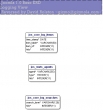Joomla (Mambo) Core ERD diagrams
I have a small project that involves an implementation of Joomla (a fork of the popular PHP/Mysql based content management system Mambo). I started with Mambo and during the time I was configuring the site, the core developers of Mambo left to create the Joomla project. The reasons for this are discussed on their OpenSourceMatters website.
Suffice it to say, I find an Entity Relationships diagram to be very helpful in understanding the architecture of a database driven application like Joomla. There wasn't one available, so I decided to reverse engineer the database, and created these diagrams, which break the core database down into a few functional areas.
UPDATED At one time my pdf version of this was hosted by Joomla, but in one of the many moves of source code, the links to it were broken. You can get the pdf with all the views here.
User and Security Subsystem

Backend (modularity and extensibility) Subsystem

Content and Presentation Subsystem

Banners

Logging

Suffice it to say, I find an Entity Relationships diagram to be very helpful in understanding the architecture of a database driven application like Joomla. There wasn't one available, so I decided to reverse engineer the database, and created these diagrams, which break the core database down into a few functional areas.
UPDATED At one time my pdf version of this was hosted by Joomla, but in one of the many moves of source code, the links to it were broken. You can get the pdf with all the views here.
User and Security Subsystem

Backend (modularity and extensibility) Subsystem

Content and Presentation Subsystem

Banners

Logging

